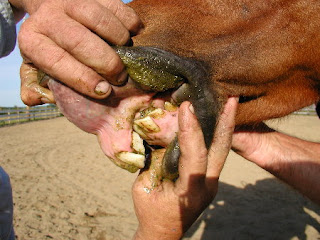Parrot Mouth (Unsoundness): When a horse's top jaw is overshot. It is inherited. It can interfere with wearing bits comfortably and eating properly.
Capped Elbow/Hock (Blemish): A fluid filling or thickening of the skin at a given point (elbow or hock). Usually due to bumping of the hocks or rubbing of the elbow while horse is laying down.
Fistulous Withers (Unsoundness): This is an inflammation of the withers. It must be treated immediately. It can be caused from ill fitting tack or trauma to the area. It can get infected, and the swelling can errupt. It can be straw colored to begin with in color, then it will turn white.
Poll Evil (Unsoundness): When the poll becomes inflamed, infected, or swollen. This is usually due to some form of trauma to the head. The area will be tender, and you will not be able to work with the horse until it is treated and healed.
Sesmoiditis (unsoundness): Inflammation of the two sesamoid bones at back of fetlock joint. Often times happens when a horse has a sloping pastern, causing the ligaments and tendons to rub more across the bones. Also more intensive sports such as racing, hunting and jumping can cause sesmoiditis. Best treatment is rest. If due to poor conformation, you may want to look into corrective shoeing to avoid it.
Cracked Hoof/Dry Hoof (Unsoundness): Dry hooves are when the hoof starts to chip away. This is due to exposed to dry conditions. It can lead to cracked hoof, where a crack forms in the the hoof running from top to bottom. Cracked hoof can also form from trauma to the area. Dry hoof can be treated by putting oil on it.










